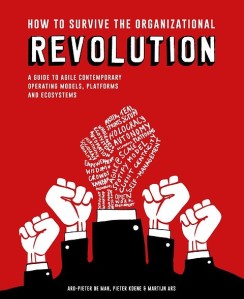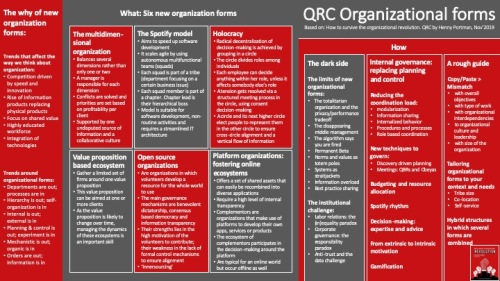 Ard-Pieter de Man, Pieter Koene and Martijn Ars wrote the book How to survive the organizational revolution – A guide to agile contemporary operating models, platforms and ecosystems. In this book you get an overview of the new organizational design landscape. Forget the business unit or matrix organization. Self-organized, dynamic and externally oriented structures replace hierarchical, stable and internally oriented structures.
Ard-Pieter de Man, Pieter Koene and Martijn Ars wrote the book How to survive the organizational revolution – A guide to agile contemporary operating models, platforms and ecosystems. In this book you get an overview of the new organizational design landscape. Forget the business unit or matrix organization. Self-organized, dynamic and externally oriented structures replace hierarchical, stable and internally oriented structures.
The book is divided in three parts. The first part gives insights why there are new organizational model (needed)? Trends that affect the way we think about organization like the competition is driven by speed and innovation. The rise of information products replacing physical products. The focus on shared value and not on shareholder value. The existence of highly educated workforce and the integration of technologies.
On the other hand, the authors see several trends around organizational forms:
- Departments are out; processes are in
- Hierarchy is out; self-organization is in
- Internal is out; external is in
- Planning & control is out; experiment is in
- Mechanistic is out; organic is in
- Orders are out; information is in
Part two focuses on the different organizational models. You get a concise and practical analysis of new organizational models like holocracy, the Spotify model, the multidimensional organization, value proposition-based ecosystem, open source organizations and platform organizations fostering online ecosystems. For each model you get a practical analysis, practical examples, enlightening case studies and a deep dive in one or more related themes (excursion). In the analysis you get answers for the following four questions: how are tasks divided? How are tasks allocated to individuals? How are rewards provided to motivate people? And how is information provided so people can take the right decisions. Attached to each model you get a sort of ‘information leaflet’ like you get from your pharmacist when you pick up your medication. In this leaflet gives answers to items like problems solved, disadvantages, suitable for, not suitable for, key ingredients, risks and leadership.
The multidimensional organization
- Balances several dimensions rather than only one or two
- A manager is responsible for each dimension
- Conflicts are solved and priorities are set based on profitability per client
- Supported by one undisputed source of information and a collaborative culture
The Spotify model
- Aims to speed up software development
- It scales agile by using autonomous multifunctional teams (squads)
- Each squad is part of a tribe (department focusing on a certain business issue)
- Each squad member is part of a chapter. Chapter lead is their hierarchical boss
- Model is suitable for software development, non-routine activities and requires a streamlined IT architecture
Holocracy
- Radical decentralization of decision-making is achieved by grouping in a circle
- The circle divides roles among individuals
- Each employee can decide anything within her role, unless it affects somebody else’s role
- A tension gets resolved via a structured meeting process in the circle, using consent decision-making
- A circle and its next higher circle elect people to represent them in the other circle to ensure cross-circle alignment and a vertical flow of information
Value proposition-based ecosystem
- Gather a limited set of firms around one value proposition
- This value proposition can be aimed at one or more clients
- As the value proposition is likely to change over time, managing the dynamics of these ecosystems is an important skill
Open source organizations
- Are organizations in which volunteers develop a resource for the whole world to use
- The main governance mechanisms are benevolent dictatorship, consensus based democracy and information transparency
- Their strengths lies in the high motivation of the volunteers to contribute; their weakness in the lack of formal control mechanisms to ensure alignment
- ‘Innersourcing’
Platform organizations: fostering online ecosystems
- Offers a set of shared assets that can easily be recombined into diverse applications
- Require a high level of internal transparency
- Complementors are organizations that make use of platforms to develop their own apps, services or products
- The ecosystem of complementors participates in the decision-making around the platform
- Are typical for an online world but occur offline as well
 To download: QRC (organizational forms, 191122) v1.0
To download: QRC (organizational forms, 191122) v1.0
The final part puts the dark side, the internal governance and what it means if you select, tailor or combine one of these models in the spotlights.
In the dark side the authors elaborate on the limits of new organizational forms like the totalitarian organization and the privacy/performance tradeoff, disappearing middle management, the algorithm says you are fired being permanently in Beta, norms and values as totem poles, systems as straitjackets, the information overload and best practice sharing.
Another topic of the dark side is the institutional challenge. How to cope with labor relations (the (in)equality paradox) and corporate governance (the responsibility paradox).
Internal governance gives answers how you can replace planning and control by reducing the coordination load (modularization, information sharing, internalized behavior, procedures and processes, role-based coordination). By using new techniques like discovery driven planning (testing of assumptions), Quarterly Business Reviews, Obeyas meetings and gamification. Using budgeting and resource allocation, the Spotify rhythm and use expertise and advice for decision-making. And last but not least how to move from extrinsic to intrinsic motivation of your people. In the deep dive an explanation of three HR trends to support the new models like an increased emphasis on developing the skills of employees, more use of vision and values as a coordination mechanism and an increasing objectivity in human resource processes.
The last chapter shows what happens if you copy/paste one of the models for your own organization in terms of a mismatch with overall objectives, type of work, organizational interdependencies, size of the organization and to organizational culture and leadership. You have to see each model as a source of inspiration. You have to tailor the organizational forms to your own context and needs (tribe size, co-location, self-service) or create your own hybrid structure as mix of two or more forms. To support your thinking you get an overview of the unique characteristics and applicability of all models
Conclusion. A great book to understand what is happening in the world of organizational design and it will help to understand if, and if yes which organizational model or a mix of these models is appropriate as a guide to design your own organizational model.
To order: How to survive the organizational revolution
Youtube: Ard-Pieter de Man – Agile for Excellence: Agile Ecosystems @ Leiden University
















Pingback: Overview of my year 2019 book reviews | Henny Portman's Blog
Pingback: Quick Reference Cards in 2019 | Henny Portman's Blog